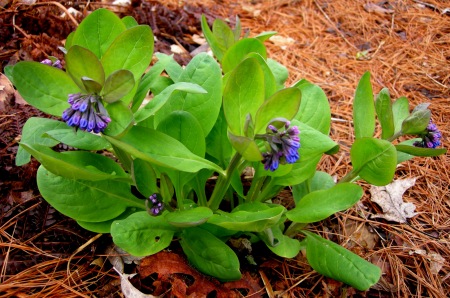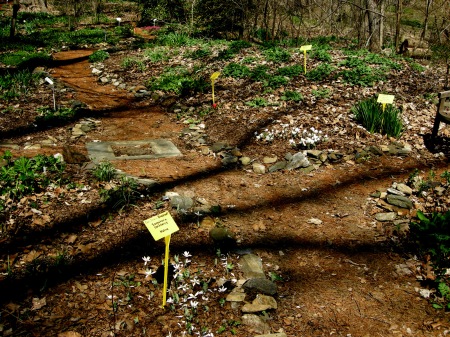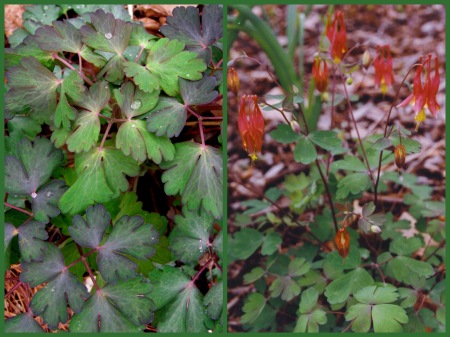 Native ‘Multiplex’ double bloodroot, Sanguinaria canadensis, is my favorite flower of all time. There is a big patch in our woodland on a very well-drained slope. ‘Multiplex’ stays in bloom a lot longer than single-flowered bloodroot, which blooms and shatters in a day or two.
Native ‘Multiplex’ double bloodroot, Sanguinaria canadensis, is my favorite flower of all time. There is a big patch in our woodland on a very well-drained slope. ‘Multiplex’ stays in bloom a lot longer than single-flowered bloodroot, which blooms and shatters in a day or two.
This post focuses on some of the more unusual and striking plants that have been flowering over the last few weeks but haven’t fit into my previous posts. Please excuse any ads that appear in the email from WordPress (the email doesn’t come from me!) announcing this post.
I am dedicating this post to Danny, Maria, Terry, Joe, and their coworkers at the Rosemont Pharmacy and all the pharmacy workers across the country who continue to work despite risk of infection so that we can get our prescriptions when we need them. In the face of their dedication, any sacrifice that we are asked to make seems minor. Please stay home to save lives.
Nursery News: Carolyn’s Shade Gardens is a retail nursery located in Bryn Mawr, PA, specializing in showy, colorful, and unusual plants for shade. The only plants that we ship are snowdrops within the US. For catalogues and announcements of local events, please send your full name, mailing address, and cell number to carolyn@carolynsshadegardens.com and indicate whether you are interested in snowdrops, hellebores, and/or hostas. Click here to get to the home page of our website for catalogues and information about our nursery and to subscribe to our blog.
. We have about 20 different magnolias in our garden, and this magnolia, ‘Black Tulip’, is one of our favorites for its beautiful habit and amazing flower color.
We have about 20 different magnolias in our garden, and this magnolia, ‘Black Tulip’, is one of our favorites for its beautiful habit and amazing flower color.
.
.
 Another much-loved magnolia is ‘Wada’s Memory’. The triangular shape is very striking. At dawn and dusk, the white flowers glow like a ghostly Christmas tree.
Another much-loved magnolia is ‘Wada’s Memory’. The triangular shape is very striking. At dawn and dusk, the white flowers glow like a ghostly Christmas tree.
.
 ‘Blue Ensign’ pulmonaria has the best blue flowers of any pulmonaria. Unfortunately, it doesn’t seem to be available anymore.
‘Blue Ensign’ pulmonaria has the best blue flowers of any pulmonaria. Unfortunately, it doesn’t seem to be available anymore.
.
 I have finally found a place in our gardens where native hepatica or liverwort thrives. It’s a south-facing open slope under a Kousa dogwood. This is sharp-lobed hepatica, H. acutiloba.
I have finally found a place in our gardens where native hepatica or liverwort thrives. It’s a south-facing open slope under a Kousa dogwood. This is sharp-lobed hepatica, H. acutiloba.
.
 Not only do the flowers on double hellebores last much longer than singles, but the plants also continue to throw out additional blooms long after the singles are done. This is ‘Harlequin Gem’ in the Winter Jewels Series with a fresh stem of flowers at the top.
Not only do the flowers on double hellebores last much longer than singles, but the plants also continue to throw out additional blooms long after the singles are done. This is ‘Harlequin Gem’ in the Winter Jewels Series with a fresh stem of flowers at the top.
. Both of my Winter Jewels ‘Peppermint Ice’ plants have new blooms right now.
Both of my Winter Jewels ‘Peppermint Ice’ plants have new blooms right now.
. The so-called “Tennessee form” of native bloodroot, Sanguinaria canadensis, has additional petals and also lasts longer than the fully single form. After many years, all forms of bloodroot are starting to seed around our garden.
The so-called “Tennessee form” of native bloodroot, Sanguinaria canadensis, has additional petals and also lasts longer than the fully single form. After many years, all forms of bloodroot are starting to seed around our garden.
. Japanese cobra lilies or jack-in-the-pulpits look beautiful when they flower, but I love what they look like as they first emerge. Here, Arisaema urashima.
Japanese cobra lilies or jack-in-the-pulpits look beautiful when they flower, but I love what they look like as they first emerge. Here, Arisaema urashima.
.
 A favorite every year, the dwarf tulip ‘Little Princess’ emerges from the gravel between stepping stones.
A favorite every year, the dwarf tulip ‘Little Princess’ emerges from the gravel between stepping stones.
.
 Growing around the base of epimediums, ‘Leeds Variety’ European wood anemone, A. nemorosa, has large and showy flowers, making it the most asked about wood anemone in our gardens.
Growing around the base of epimediums, ‘Leeds Variety’ European wood anemone, A. nemorosa, has large and showy flowers, making it the most asked about wood anemone in our gardens.
.
 The delicate, green flowers of ‘Viridiflora’ European wood anemone reappeared among the branches of a creeping juniper last year after disappearing from our garden over 15 years ago. It’s a mystery!
The delicate, green flowers of ‘Viridiflora’ European wood anemone reappeared among the branches of a creeping juniper last year after disappearing from our garden over 15 years ago. It’s a mystery!
.
 What we call our “river” of native ‘Sherwood Purple’ creeping phlox, P. stolonifera, is quite a sight when it blooms.
What we call our “river” of native ‘Sherwood Purple’ creeping phlox, P. stolonifera, is quite a sight when it blooms.
.
 Native shooting star, Dodecatheon media, also thrives in the open, south-facing bed under a Kousa dogwood.
Native shooting star, Dodecatheon media, also thrives in the open, south-facing bed under a Kousa dogwood.
.
 Japanese woodland primroses, Primula sieboldii, thrive in the full, dry shade under our American hornbeam.
Japanese woodland primroses, Primula sieboldii, thrive in the full, dry shade under our American hornbeam.
.
 There are over 500 flower forms of Japanese woodland primroses. I especially like this one, but it didn’t come with a cultivar name.
There are over 500 flower forms of Japanese woodland primroses. I especially like this one, but it didn’t come with a cultivar name.
.
 ‘Spotty Dotty’ Asian mayapple, Podophyllum, attracts a lot of attention in our garden. For customers who were here last year, this is the plant that we had in a pot in the nursery. It did quite well in the pot, and then we planted it in the garden last fall. We have another even bigger plant that is at least five years old.
‘Spotty Dotty’ Asian mayapple, Podophyllum, attracts a lot of attention in our garden. For customers who were here last year, this is the plant that we had in a pot in the nursery. It did quite well in the pot, and then we planted it in the garden last fall. We have another even bigger plant that is at least five years old.
.
 Considered the king of all shade plants by some, Japanese wood poppy, Glaucidium palmatum, takes many years to reach this size and bloom.
Considered the king of all shade plants by some, Japanese wood poppy, Glaucidium palmatum, takes many years to reach this size and bloom.
Blogs are a lot more fun for everyone, especially the writer, when readers leave comments. Scroll down to the end of the page to the box where it says “Leave a Reply” and start typing—-it’s easy!
Carolyn
Notes: Every word that appears in orange on my blog is a link that you can click for more information. If you want to return to my blog’s homepage to access the sidebar information (catalogues, previous articles, etc.) or to subscribe to my blog, just click here.







































































